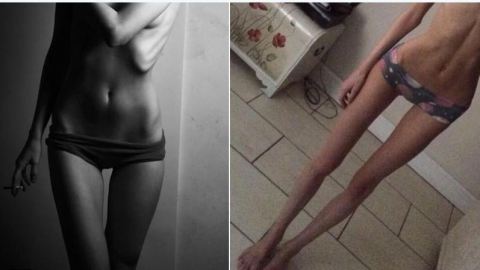Anorexics Showing Off Their “Thinspirational” Bodies on Social Media

Search for “thinspo” or “thinspiration” on your favorite social network and a stream of body parts will flood your page. Heads are often cropped, showing only legs, torsos, or backs that have been pushed to their thinnest. The people in these images have torsos with ribcages tight against their skin and other body parts that look to be begging for nutrients.
These “thinspirational” images surround a group of people that are “pro-ana” or “pro-anorexia.” The mentalities within these groups vary from people who are anorexic that are seeking a non-judgmental place on the web with the aim of getting better to people who believe anorexia is a “lifestyle choice.” The latter, of course, is quite dangerous.
Researchers from the University of California recently assessed the images related to the thinspo and thinspirational tags on social media, and they found a majority of them cast anorexia in a positive light. The researchers examined a total of 300 images from Pinterest and Twitter associated with these terms. Doctoral candidate Jannath Ghaznavi had this to say in a press release:
“Imagine a teenage girl or even a young woman looking for inspiration using terms such as ‘attractive,’ ‘fit,’ or ‘pretty.’ She will likely find images of headless, scantily clad, sexualized women and their body parts.”
Teens are already bombarded with magazine ads showing airbrushed women with slim waistlines — an unhealthy ambition. Some countries have started combating these unhealthy standards of “beauty.” France, for instance, recently considered enacting a law to regulate models’ BMIs — anyone found to be under the 18-point mark would be banned from working in the industry.
The internet is a place where unhealthy ideas can take root, and grow into movements — some good, some bad. Climate change deniers and anti-vaccination groups are just two that have exploded in recent years. So, in a place where anyone can shout out an unhealthy way of living as a “lifestyle choice,” Ghaznavi only had this to say:
“A young woman looking at these images may think that’s what she should look like. That could prompt these girls and women to resort to extreme dieting, excessive exercise, or other harmful behaviors in order to achieve this thin ideal.”
The researchers admit that they have no data to say how effective these images and groups are, or even if they’ve contributed to a growing rate of eating disorders among teens. However, they point to past studies that have shown how exposure to such images can lead to body dissatisfaction. Indeed, but the fact that support groups exist — easily accessible — for teens to explore unhealthy dieting habits is disconcerting, and without a solution.
Read more at EurekAlert!
Photo Credit: Shutterstock




